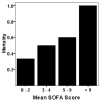Predictors of outcome in myxoedema coma: a study from a tertiary care centre
- PMID: 18173846
- PMCID: PMC2374608
- DOI: 10.1186/cc6211
Predictors of outcome in myxoedema coma: a study from a tertiary care centre
Abstract
Background: With the easy availability of thyroid hormone assays, thyroid disorders are now recognised even in a subclinical state. However, patients are still seen with advanced manifestations of the disease, particularly in developing countries. This observational study analysed the predictors of outcome in patients with myxoedema coma and tested the validity of different modules to define morbidity and mortality in these patients.
Methods: Twenty-three consecutive patients with myxoedema coma who presented from January 1999 to August 2006 were studied. The thyroid function test and random serum cortisol were measured in all patients at the time of admission. Patients were given oral or intravenous (i.v.) thyroxine with intention to treat with the latter according to availability. Various modules that predict outcome, including Glasgow Coma Scale (GCS), Acute Physiology and Chronic Health Evaluation II (APACHE II) score, and Sequential Organ Failure Assessment (SOFA) score, were analysed. SOFA score was repeated every 2 days until the time of discharge or demise.
Results: Twenty-three patients (20 women; 87%) of 59.5 +/- 14.4 years of age (range, 30 to 89 years) were seen during the study period. Nine (39%) patients were diagnosed with hypothyroidism for the first time at the time of presentation of myxoedema coma, whereas 14 (70%) were diagnosed with hypothyroidism previously. However, the treatment defaulters presented early to the hospital and had more severe manifestations than de novo subjects. Nineteen (82%) had thyroprivic (primary) and 4 (17%) had trophoprivic (secondary) hypothyroidism. Fifteen (65%) patients presented in the winter and in 17 (74%) sepsis was the major accompanying comorbidity. Twelve (52%) had a history of diuretic use, thereby delaying the initial diagnosis. Patients who received oral L-thyroxine had no difference in outcome from those receiving i.v. thyroxine. Twelve (52%) subjects died and sepsis was the predominant cause of death. Various predictors of mortality included hypotension (p = 0.01) and bradycardia (p = 0.03) at presentation, need for mechanical ventilation (p = 0.00), hypothermia unresponsive to treatment (p = 0.01), sepsis (p = 0.01), intake of sedative drugs (p = 0.02), lower GCS (p = 0.03), high APACHE II score (p = 0.04), and high SOFA score (p = 0.00). However, SOFA score was more effective than other predictive models as baseline and day 3 SOFA scores of more than 6 were highly predictive of poor outcome.
Conclusion: L-Thyroxine treatment defaulters had more severe manifestations compared with de novo subjects. Outcome was not influenced by either aetiology or route of administration of L-thyroxine, and SOFA score was the best outcome predictor model.
Figures
Comment in
-
Predictors of outcome in myxoedema coma.Crit Care. 2008;12(1):111. doi: 10.1186/cc6218. Epub 2008 Jan 23. Crit Care. 2008. PMID: 18254932 Free PMC article.
References
-
- Wall CR. Myxoedema coma: diagnosis and treatment. Am Fam Physi. 2000;62:2485–2490. - PubMed
-
- Galofré JC, García-Mayor RV. Densidad de incidencia del coma mixedematoso. Endocrinologia. 1997;44:103–104.
MeSH terms
Substances
LinkOut - more resources
Full Text Sources



